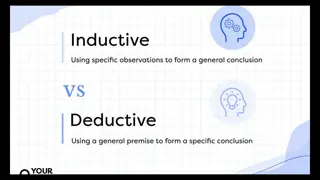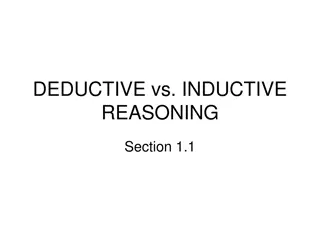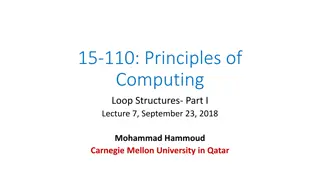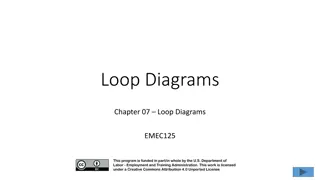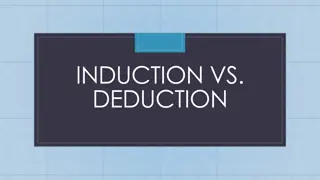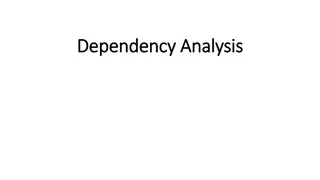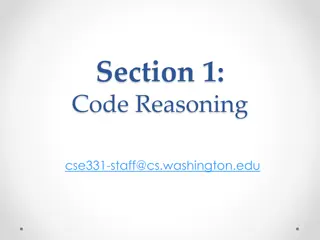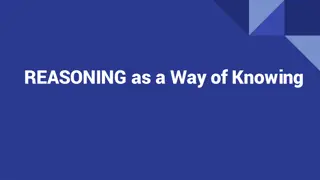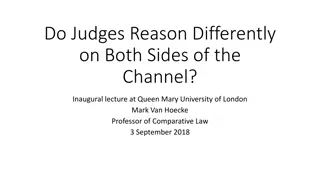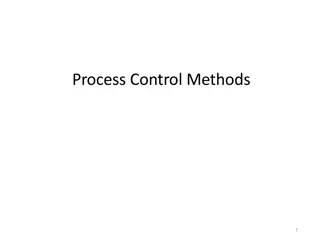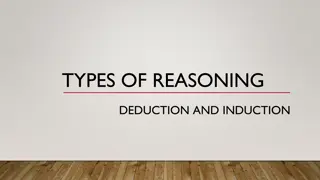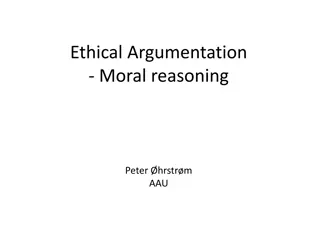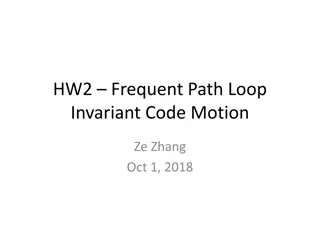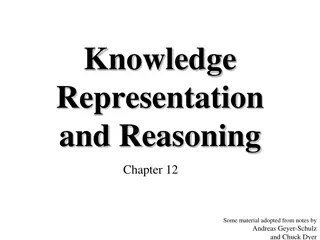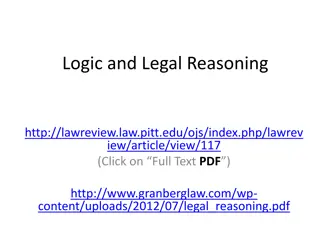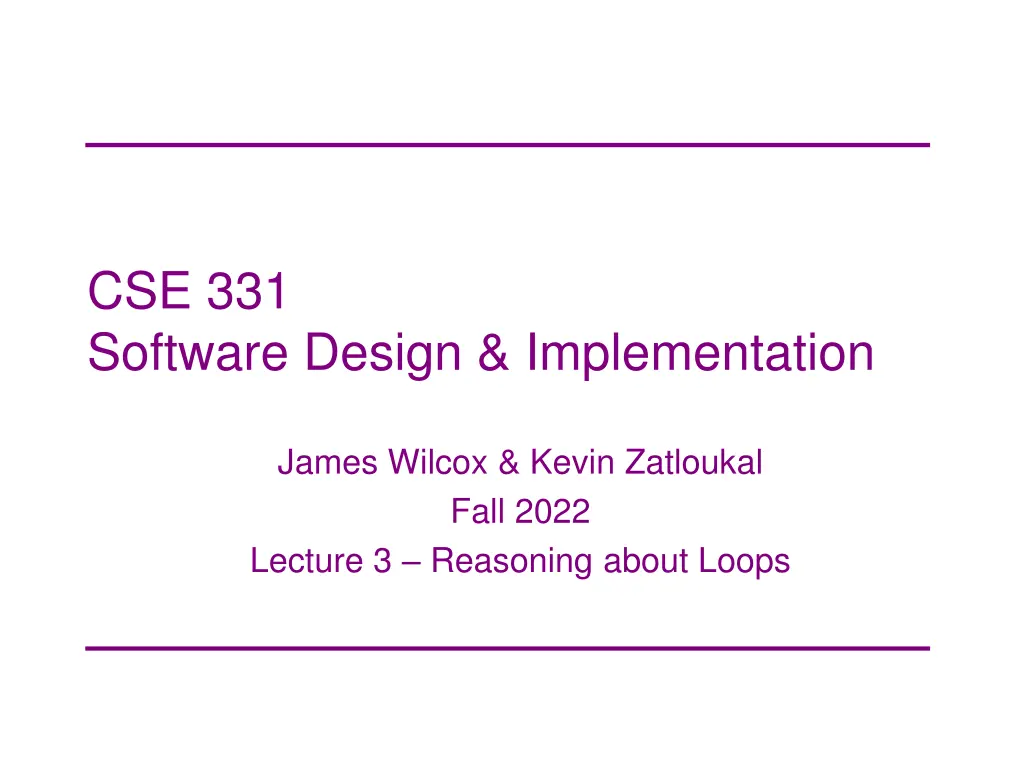
Understanding Forward and Backward Reasoning in Software Design
Learn about the concepts of forward and backward reasoning in software design, including Floyd's logic, Hoare triples, and correctness validation. Discover how to reason about loops, assignments, and the subtleties involved in forward reasoning. Gain insights into fixing issues that may arise in software correctness validation using subscripts for old variable values.
Download Presentation

Please find below an Image/Link to download the presentation.
The content on the website is provided AS IS for your information and personal use only. It may not be sold, licensed, or shared on other websites without obtaining consent from the author. If you encounter any issues during the download, it is possible that the publisher has removed the file from their server.
You are allowed to download the files provided on this website for personal or commercial use, subject to the condition that they are used lawfully. All files are the property of their respective owners.
The content on the website is provided AS IS for your information and personal use only. It may not be sold, licensed, or shared on other websites without obtaining consent from the author.
E N D
Presentation Transcript
CSE 331 Software Design & Implementation James Wilcox & Kevin Zatloukal Fall 2022 Lecture 3 Reasoning about Loops
Floyd Logic A Hoare triple is two assertions and one piece of code: { P } S { Q } P the precondition S the code Q the postcondition specification method body A Hoare triple { P } S { Q } is called valid if: in any state where P holds, executing S produces a state where Q holds i.e., if P is true before S, then Q must be true after it otherwise, the triple is called invalid code is correct iff triple is valid CSE 331 Fall 2022 2
Reasoning Forward & Backward Forward: start with the given precondition fill in the strongest postcondition { P}S{ ? } Backward start with the required postcondition fill in the weakest precondition { ?}S{ Q} Finds the best assertion that makes the triple valid CSE 331 Fall 2022 3
Reasoning: Assignments x = expr Forward add the fact x = expr to what is known BUT you must fix any existing references to x Backward just replace any x in the postcondition with expr (substitution) CSE 331 Fall 2022 4
Correctness by Forward / Backward Reasoning in either direction gives valid assertions Just need to check adjacent assertions: top assertion must imply bottom one {{ P }} S1 S2 {{ P1 }} {{ Q }} {{ P }} {{ Q1 }} S1 {{ P }} S1 {{ P1 }} S2 {{ Q }} {{ Q1 }} S2 {{ Q }} CSE 331 Fall 2022 5
Subtleties in Forward Reasoning... Forward reasoning can fail if applied blindly... {{ }} w = x + y; {{ w = x + y }} x = 4; {{ w = x + y and x = 4 }} y = 3; {{ w = x + y and x = 4 and y = 3 }} This implies that w = 7, but that is not true! w equals whatever x + y was before they were changed CSE 331 Fall 2022 6
Fix 1 Use subscripts to refer to old values of the variables Un-subscripted variables should always mean current value {{ }} w = x + y; {{ w = x + y }} x = 4; {{ w = x1 + y and x = 4 }} y = 3; {{ w = x1 + y1 and x = 4 and y = 3 }} CSE 331 Fall 2022 7
Fix 2 (better) Express prior values in terms of the current value {{ }} w = x + y; {{ w = x + y }} x = x + 4; {{ w = x1 + y and x = x1 + 4 }} {{ w = x - 4 + y }} Now, x1 = x - 4 So w = x1 + y w = x - 4 + y Note for updating variables, e.g., x = x + 4: Backward reasoning just substitutes new value (no change) Forward reasoning requires you to invert the + operation CSE 331 Fall 2022 8
If Statements Forward reasoning {{ P }} if (cond) S1 else S2 {{ ? }} CSE 331 Fall 2022 10
If Statements Forward reasoning {{ P }} if (cond) {{ P and cond }} S1 else {{ P and not cond }} S2 {{ ? }} CSE 331 Fall 2022 11
If Statements Forward reasoning {{ P }} if (cond) {{ P and cond }} S1 {{ P1 }} else {{ P and not cond }} S2 {{ P2 }} {{ ? }} CSE 331 Fall 2022 12
If Statements Forward reasoning {{ P }} if (cond) {{ P and cond }} S1 {{ P1 }} else {{ P and not cond }} S2 {{ P2 }} {{ P1 or P2 }} CSE 331 Fall 2022 13
If Statements Backward reasoning {{ ? }} if (cond) S1 else S2 {{ Q }} CSE 331 Fall 2022 14
If Statements Backward reasoning {{ ? }} if (cond) S1 {{ Q }} else S2 {{ Q }} {{ Q }} CSE 331 Fall 2022 15
If Statements Backward reasoning {{ ? }} if (cond) {{ Q1 }} S1 {{ Q }} else {{ Q2 }} S2 {{ Q }} {{ Q }} CSE 331 Fall 2022 16
If Statements Backward reasoning {{ condand Q1 or notcond and Q2 }} if (cond) {{ Q1 }} S1 {{ Q }} else {{ Q2 }} S2 {{ Q }} {{ Q }} CSE 331 Fall 2022 17
If-Statement Example Forward reasoning {{ }} if (x >= 0) y = x; else y = -x; {{ ? }} CSE 331 Fall 2022 18
If-Statement Example Forward reasoning {{ }} if (x >= 0) {{ x >= 0 }} y = x; else {{ x < 0 }} y = -x; {{ ? }} CSE 331 Fall 2022 19
If-Statement Example Forward reasoning {{ }} if (x >= 0) {{ x >= 0 }} y = x; {{ x >= 0 and y = x }} else {{ x < 0 }} y = -x; {{ x < 0 and y = -x }} {{ ? }} CSE 331 Fall 2022 20
If-Statement Example Forward reasoning {{ }} if (x >= 0) {{ x >= 0 }} y = x; {{ x >= 0 and y = x }} else {{ x < 0 }} y = -x; {{ x < 0 and y = -x }} {{ (x >= 0 and y = x) or (x < 0 and y = -x) }} CSE 331 Fall 2022 21
If-Statement Example Forward reasoning {{ }} if (x >= 0) {{ x >= 0 }} y = x; {{ x >= 0 and y = x }} else {{ x < 0 }} y = -x; {{ x < 0 and y = -x }} {{ y = |x| }} CSE 331 Fall 2022 22
If-Statement Example Forward reasoning {{ }} if (x >= 0) {{ x >= 0 }} y = x; {{ x >= 0 and y = x }} else {{ x < 0 }} y = -x; {{ x < 0 and y = -x }} {{ y = |x| }} Warning: many write {{ y >= 0 }} here That is true but it is strictly weaker. (It includes cases where y != x) CSE 331 Fall 2022 23
If-Statement Example Forward reasoning Backward reasoning {{ }} if (x >= 0) {{ x >= 0 }} y = x; {{ x >= 0 and y = x }} else {{ x < 0 }} y = -x; {{ x < 0 and y = -x }} {{ y = |x| }} {{ ? }} if (x >= 0) y = x; else y = -x; {{ y = |x| }} CSE 331 Fall 2022 24
If-Statement Example Forward reasoning Backward reasoning {{ }} if (x >= 0) {{ x >= 0 }} y = x; {{ x >= 0 and y = x }} else {{ x < 0 }} y = -x; {{ x < 0 and y = -x }} {{ y = |x| }} {{ ? }} if (x >= 0) y = x; {{ y = |x| }} else y = -x; {{ y = |x| }} {{ y = |x| }} CSE 331 Fall 2022 25
If-Statement Example Forward reasoning Backward reasoning {{ }} if (x >= 0) {{ x >= 0 }} y = x; {{ x >= 0 and y = x }} else {{ x < 0 }} y = -x; {{ x < 0 and y = -x }} {{ y = |x| }} {{ ? }} if (x >= 0) {{ x = |x| }} y = x; {{ y = |x| }} else {{ -x = |x| }} y = -x; {{ y = |x| }} {{ y = |x| }} CSE 331 Fall 2022 26
If-Statement Example Forward reasoning Backward reasoning {{ }} if (x >= 0) {{ x >= 0 }} y = x; {{ x >= 0 and y = x }} else {{ x < 0 }} y = -x; {{ x < 0 and y = -x }} {{ y = |x| }} {{ ? }} if (x >= 0) {{ x >= 0 }} y = x; {{ y = |x| }} else {{ x <= 0 }} y = -x; {{ y = |x| }} {{ y = |x| }} CSE 331 Fall 2022 27
If-Statement Example Forward reasoning Backward reasoning {{ (x >= 0 and x >= 0) or (x < 0 and x <= 0) }} if (x >= 0) {{ x >= 0 }} y = x; {{ y = |x| }} else {{ x <= 0 }} y = -x; {{ y = |x| }} {{ y = |x| }} {{ }} if (x >= 0) {{ x >= 0 }} y = x; {{ x >= 0 and y = x }} else {{ x < 0 }} y = -x; {{ x < 0 and y = -x }} {{ y = |x| }} CSE 331 Fall 2022 28
If-Statement Example Forward reasoning Backward reasoning {{ }} if (x >= 0) {{ x >= 0 }} y = x; {{ x >= 0 and y = x }} else {{ x < 0 }} y = -x; {{ x < 0 and y = -x }} {{ y = |x| }} {{ x >= 0 or x < 0 }} if (x >= 0) {{ x >= 0 }} y = x; {{ y = |x| }} else {{ x <= 0 }} y = -x; {{ y = |x| }} {{ y = |x| }} CSE 331 Fall 2022 29
If-Statement Example Forward reasoning Backward reasoning {{ }} if (x >= 0) {{ x >= 0 }} y = x; {{ x >= 0 and y = x }} else {{ x < 0 }} y = -x; {{ x < 0 and y = -x }} {{ y = |x| }} {{ }} if (x >= 0) {{ x >= 0 }} y = x; {{ y = |x| }} else {{ x <= 0 }} y = -x; {{ y = |x| }} {{ y = |x| }} CSE 331 Fall 2022 30
Reasoning So Far Mechanical reasoning for assignment and if statements All code (essentially) can be written just using: assignments if statements while loops Only part we are missing is loops (We will also cover function calls later.) CSE 331 Fall 2022 31
Reasoning About Loops Loop reasoning is not as easy as with = and if recall Rice s Theorem (from 311): checking any non-trivial semantic property about programs is undecidable We need help (more information) before the reasoning again becomes a mechanical process That help comes in the form of a loop invariant CSE 331 Fall 2022 33
Loop Invariant A loop invariant is an assertion that holds at the top of the loop: {{ Inv: I }} while (cond) S It holds when we first get to the loop. It holds each time we execute S and come back to the top. Notation: I ll use Inv: to indicate a loop invariant. CSE 331 Fall 2022 Lupin variants
Checking Correctness of a Loop Consider a while-loop (other loop forms not too different) with a loop invariant I. Let s try forward reasoning... {{ P }} S1 {{ Inv: I }} while (cond) S2 S3 {{ Q }} CSE 331 Fall 2022 35
Checking Correctness of a Loop Consider a while-loop (other loop forms not too different) with a loop invariant I. Let s try forward reasoning... {{ P }} S1 {{ P1 }} Need to check that P1 implies I (i.e., that I is true the first time) {{ Inv: I }} while (cond) S2 S3 {{ Q }} CSE 331 Fall 2022 36
Checking Correctness of a Loop Consider a while-loop (other loop forms not too different) with a loop invariant I. Let s try forward reasoning... {{ P }} S1 {{ Inv: I }} while (cond) {{ I and cond }} S2 {{ P2 }} Need to check that P2 implies I again (i.e., that I is true each time around) S3 {{ Q }} CSE 331 Fall 2022 37
Checking Correctness of a Loop Consider a while-loop (other loop forms not too different) with a loop invariant I. Let s try forward reasoning... {{ P }} S1 {{ Inv: I }} while (cond) S2 {{ I and not cond }} S3 {{ P3 }} {{ Q }} Need to check that P3 implies Q (i.e., Q holds after the loop)
Checking Correctness of a Loop Consider a while-loop (other loop forms not too different) with a loop invariant I. {{ P }} S1 Informally, we need: I holds initially I holds each time around Q holds after we exit {{ Inv: I }} while (cond) S2 Formally, we need validity of: {{ P }} S1 {{ I }} {{ I and cond }} S2 {{ I }} {{ I and not cond }} S3 {{ Q }} S3 {{ Q }} (can check these with backward reasoning instead) CSE 331 Fall 2022 39
More on Loop Invariants Loop invariants are crucial information needs to be provided before reasoning is mechanical Pro Tip: always document your invariants for non-trivial loops don t make code reviewers guess the invariant Pro Tip: with a good loop invariant, the code is easy to write all the creativity can be saved for finding the invariant more on this in later lectures CSE 331 Fall 2022 40
Example: sum of array Consider the following code to compute b[0] + + b[n-1]: {{ }} s = 0; i = 0; while (i != n) { s = s + b[i]; i = i + 1; } {{ s = b[0] + ... + b[n-1] }} Equivalent to this for loop: s = 0; for (int i = 0; i != n; i++) s = s + b[i]; CSE 331 Fall 2022 41
Example: sum of array Consider the following code to compute b[0] + + b[n-1]: {{ }} s = 0; i = 0; {{ Inv: s = b[0] + ... + b[i-1] }} while (i != n) { s = s + b[i]; i = i + 1; } {{ s = b[0] + ... + b[n-1] }} CSE 331 Fall 2022 42
Example: sum of array Consider the following code to compute b[0] + + b[n-1]: {{ }} s = 0; i = 0; {{ s = 0 and i = 0 }} {{ Inv: s = b[0] + ... + b[i-1] }} while (i != n) { s = s + b[i]; i = i + 1; } {{ s = b[0] + ... + b[n-1] }} CSE 331 Fall 2022 43
Example: sum of array Consider the following code to compute b[0] + + b[n-1]: (s = 0 and i = 0) implies s = b[0] + + b[i-1] ? {{ }} s = 0; i = 0; {{ s = 0 and i = 0 }} {{ Inv: s = b[0] + ... + b[i-1] }} while (i != n) { s = s + b[i]; i = i + 1; } {{ s = b[0] + ... + b[n-1] }} Less formal s = sum of first i numbers in b CSE 331 Fall 2022 44
Example: sum of array Consider the following code to compute b[0] + + b[n-1]: (s = 0 and i = 0) implies s = b[0] + + b[i-1] ? {{ }} s = 0; i = 0; {{ s = 0 and i = 0 }} {{ Inv: s = b[0] + ... + b[i-1] }} while (i != n) { s = s + b[i]; i = i + 1; } {{ s = b[0] + ... + b[n-1] }} Less formal s = sum of first i numbers in b When i = 0, s needs to be the sum of the first 0 numbers, so we need s = 0. CSE 331 Fall 2022 45
Example: sum of array Consider the following code to compute b[0] + + b[n-1]: (s = 0 and i = 0) implies s = b[0] + + b[i-1] ? {{ }} s = 0; i = 0; {{ s = 0 and i = 0 }} {{ Inv: s = b[0] + ... + b[i-1] }} while (i != n) { s = s + b[i]; i = i + 1; } {{ s = b[0] + ... + b[n-1] }} More formal s = sum of all b[k] with 0 k i-1 CSE 331 Fall 2022 46
Example: sum of array Consider the following code to compute b[0] + + b[n-1]: (s = 0 and i = 0) implies s = b[0] + + b[i-1] ? {{ }} s = 0; i = 0; {{ s = 0 and i = 0 }} {{ Inv: s = b[0] + ... + b[i-1] }} while (i != n) { s = s + b[i]; i = i + 1; } {{ s = b[0] + ... + b[n-1] }} More formal s = sum of all b[k] with 0 k i-1 i = 3 (0 k 2): s = b[0] + b[1] + b[2] i = 2 (0 k 1): s = b[0] + b[1] i = 1 (0 k 0): s = b[0] i = 0 (0 k -1) s = 0 CSE 331 Fall 2022 47
Example: sum of array Consider the following code to compute b[0] + + b[n-1]: (s = 0 and i = 0) implies s = b[0] + + b[i-1] ? {{ }} s = 0; i = 0; {{ s = 0 and i = 0 }} {{ Inv: s = b[0] + ... + b[i-1] }} while (i != n) { s = s + b[i]; i = i + 1; } {{ s = b[0] + ... + b[n-1] }} More formal s = sum of all b[k] with 0 k i-1 when i = 0, we want to sum over all indexes k satisfying 0 k -1 There are no such indexes, so we need s = 0 CSE 331 Fall 2022 48
Example: sum of array Consider the following code to compute b[0] + + b[n-1]: (s = 0 and i = 0) implies s = b[0] + + b[i-1] ? {{ }} s = 0; i = 0; {{ s = 0 and i = 0 }} {{ Inv: s = b[0] + ... + b[i-1] }} while (i != n) { s = s + b[i]; i = i + 1; } {{ s = b[0] + ... + b[n-1] }} Yes. (An empty sum is zero.) CSE 331 Fall 2022 49
Example: sum of array Consider the following code to compute b[0] + + b[n-1]: (s = 0 and i = 0) implies I {{ }} s = 0; i = 0; {{ s = 0 and i = 0 }} {{ Inv: s = b[0] + ... + b[i-1] }} while (i != n) { s = s + b[i]; i = i + 1; } {{ s = b[0] + ... + b[n-1] }} CSE 331 Fall 2022 50

